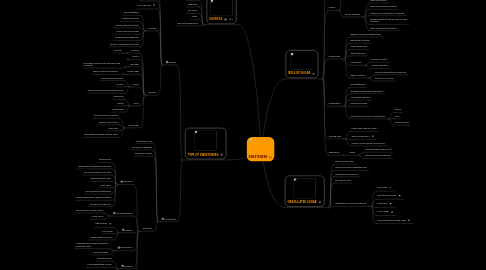
1. TYPE OF SWEETENERS
1.1. nutritive
1.1.1. 4 cal per g
1.1.2. processing
1.1.3. occur naturally
1.1.4. function
1.1.4.1. give sweet&bulk
1.1.4.2. maintain freshness
1.1.4.3. preservatives(jam/jellies)
1.1.4.4. flavor enhancer for meat
1.1.4.5. fermentation bread&pickle
1.1.4.6. bpdy to carbonated beveranges
1.1.5. example
1.1.5.1. fructose
1.1.5.1.1. all fruits
1.1.5.2. polyols
1.1.5.2.1. sugar alcohol
1.1.5.2.2. sorbitol
1.1.5.2.3. mannitol
1.1.5.2.4. humectants
1.1.5.3. raw sugar
1.1.5.3.1. form when moisture from the sugar cane evaporate
1.1.5.4. brown sugar
1.1.5.4.1. sugar crystal from mollases
1.1.5.5. honey
1.1.5.5.1. fructose+glucose+water
1.1.5.5.2. by bees
1.1.5.5.3. dark color(more acidic&strongly flavor)
1.1.5.6. HFCS
1.1.5.6.1. hydrolyzed
1.1.5.6.2. refined
1.1.5.6.3. concentrated
1.1.5.7. invert sugar
1.1.5.7.1. divide to glucose+fructose
1.1.5.7.2. sweeter than sucrose
1.1.5.7.3. liquid form
1.1.5.7.4. keep candies and baked remain sweet
1.2. non-nutiritve
1.2.1. most widely used
1.2.2. non caloric sweetener
1.2.3. chemically process
1.2.4. advantage
1.2.4.1. aspartame
1.2.4.1.1. economically
1.2.4.1.2. widely used in carbonate beverages
1.2.4.1.3. 180-200x sweet than sucrose
1.2.4.1.4. enhance&extent flavor
1.2.4.1.5. holds flavor
1.2.4.1.6. do not promote tooth decay
1.2.4.1.7. variety&flexibility for diabetic patients
1.2.4.1.8. no affect blood glucose
1.2.4.2. sucralose(splenda)
1.2.4.2.1. not recognize as sugar of CHO
1.2.4.2.2. x raise insulin
1.2.4.3. neotame
1.2.4.3.1. high potency
1.2.4.3.2. cost saving
1.2.4.3.3. reduce logistic resources
1.2.4.4. acesulfame-K
1.2.4.4.1. + aspartame will exhibit a significant synergistic affect
1.2.4.4.2. large cost saving
1.2.4.5. saccharin
1.2.4.5.1. nonmetabolized
1.2.4.5.2. 300x sweeter than sucrose
1.2.4.5.3. high concentration can detect unpleasent aftertaste
1.2.4.6. cyclamate
1.2.4.6.1. 30x more patent than sugar
1.2.4.6.2. aftertaste(minor) compare saccharin/acesulfame-K
1.2.4.6.3. cyclamate+saccharin(10:1) imparts more round taste
2. SOURCES
2.1. sugar cane
2.2. sugar beat
2.3. corn syrup
2.4. honey
2.5. fruit juice/concentrate
3. ROLE OF SUGAR
3.1. sweetness
3.1.1. combination sugar+fat
3.1.2. provide sweet taste and texture without alter flavour
3.2. texture
3.2.1. ice cream
3.2.1.1. provide body+ texture (smoothness)
3.2.1.2. prevent lactose crystallize
3.2.2. bakery products
3.2.2.1. sugar recrystallize
3.2.2.2. water removed(crisp texture)
3.2.2.3. cripness increased effect of browning
3.2.2.4. tenderize product(slow the rate of starch molecule)
3.2.2.5. water removed)crisp texture)
3.3. preservation
3.3.1. inhibit microbial growth&spoilage
3.3.2. high affinity of water
3.3.3. slow moisture loss
3.3.4. extend shelf life
3.3.5. can product
3.3.5.1. maintain firmness
3.3.5.2. minimize oxidation
3.3.6. inhibit oxidation
3.3.6.1. prevent deteriorate flavor&texture
3.3.6.2. prevent loss of color
3.4. fermentation
3.4.1. brewing&baking
3.4.2. increased dough yield(fermentation)
3.4.3. contribute sweetness
3.4.4. softness the bread
3.4.5. sugar that remain after ferment affect
3.4.5.1. flavour
3.4.5.2. color
3.4.5.3. texture of crust
3.5. freezing point
3.5.1. frozen desert and ice cream
3.5.2. lower freezing point
3.5.3. small ice crystal, greater smoothness
3.6. appearance
3.6.1. baked
3.6.1.1. caramelize(dark brown crust)
3.6.1.2. Maillard reaction (browning)
4. GRANULATED SUGAR
4.1. most common sugar
4.2. obtain from sugar cane&sugar beat
4.3. more than 99.8% sucrose
4.4. pure sweet flavor
4.5. manufacture in various crystal size
4.5.1. table sugar
4.5.2. extra/ultra fine sugar
4.5.3. icing sugar
4.5.4. coarse sugar
4.5.5. decorative/pearl/sanding sugar
